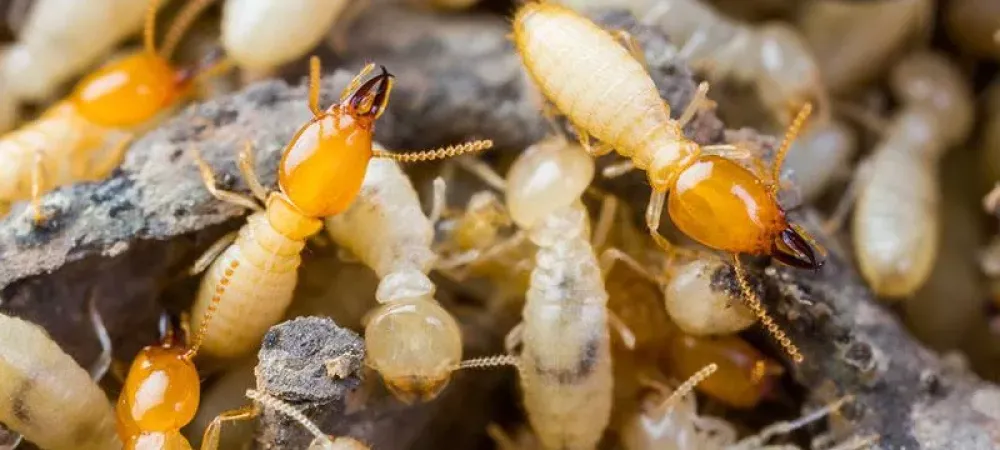Termites in Southwestern Illinois: Signs, Damage, and Prevention Tips

Termites are a significant concern for homeowners in Southwestern Illinois. While these insects are feared nationwide, it's crucial to understand the specific termite species that affect our region. In Southwestern Illinois, the Eastern Subterranean Termite is the primary culprit when it comes to potential property damage.
Eastern Subterranean Termites: The Local Threat
Eastern subterranean termites are prevalent throughout Illinois, including the southwestern region. These pests are most active during spring and summer, which is when they typically swarm in search of new food sources and nesting sites.
What do Eastern Subterranean Termites Look Like?
Eastern subterranean termites are widespread across Illinois, particularly in the southwestern region, where they thrive in the humid climate. These destructive pests are most active during the warmer months of spring and summer. This period marks their swarming season, when winged termites, known as alates, leave their colonies to establish new nesting sites and search for fresh food sources. To protect your home, it's essential to recognize these wood-destroying insects:
- Size: Eastern subterranean termites measure 1/4 to 3/8 inch in length.
- Appearance: They have small, plump bodies divided into three parts: head, thorax, and abdomen.
- Color: Workers are pale or whitish, often mistaken for white ants.
- Features: Straight antennae, thick waists, and rounded heads (workers) or elongated heads (soldiers).
- Wings: Brownish-gray wings used for swarming
Do Termites Fly?
Yes, termites do fly, but their flight is different from that of bees or flies. During their swarming season, winged termites, or alates, take short flights to find mates and establish new colonies. Unlike other flying insects, their flight is limited in distance, and they typically don’t fly in large, coordinated groups. After swarming, they shed their wings and begin their search for a suitable nesting site. If you see discarded wings around your home, it’s a strong indication of termite activity.
Termite Swarming in Southwestern Illinois
Termite swarming is critical in the termite life cycle and is often one of the first signs of a potential infestation. Understanding the timing, purpose, and behavior of swarming termites can help homeowners identify and address problems early. Eastern subterranean termites swarm in the spring or summer, so this is a great time to look into professional termite treatment in Southwestern Illinois!
- Timing: Eastern subterranean termites typically swarm during the warmer months of spring and summer, with peak activity occurring in late spring. During this period, environmental conditions, such as warmth and moisture, are ideal for termite reproduction. Swarming usually happens on warm, sunny days after a rainfall, when termites are most active.
- Purpose: The primary purpose of termite swarming is to establish new colonies. During a swarm, winged termites, known as alates, leave the parent colony, searching for suitable environments to create new colonies. They are drawn to structures with abundant wood sources, making homes particularly vulnerable.
- Behavior: After swarming, the winged termites shed their wings and pair off to mate. These mated termites, now called "kings" and "queens," begin the process of finding a nesting site. Once they settle in a new location, they will start laying eggs and establishing a colony. Homeowners may notice piles of discarded wings near windowsills, doors, or light sources, a common sign of termite swarming activity.
Signs of Termite Activity
Termites can cause significant damage before their presence is detected, so it’s important to be vigilant for early signs of an infestation. In Southwestern Illinois, homeowners should watch for the following indicators:
- Mud Tubes on Exterior Walls or Foundations: Mud tubes are tunnels termites build to travel between their colony and food sources, often seen on walls or foundations.
- Piles of Sawdust-like Material: Termite droppings, resembling sawdust, are found near areas where termites are feeding on wood.
- Visible Damage to Wood Structures: Termites weaken wood by feeding on it, causing soft, hollowed-out beams or floors.
- Swarming Termites or Discarded Wings: During swarming season, winged termites may appear near light sources, with discarded wings found around windowsills.
Preventing Termites
There are several steps you can take to help prevent termites from infesting your home:
- Eliminate Moisture: Reduce excess moisture around your property by fixing leaks and ensuring proper ventilation in crawl spaces and basements.
- Store Firewood Away from Your Home: To avoid attracting termites, keep firewood, wooden materials, and other cellulose-based items at least 20 feet away from your home’s foundation.
- Trim Shrubs and Trees: Prune back shrubs, tree branches, and vegetation that are in contact with your home’s exterior to limit termite access.
- Seal Cracks and Crevices: Inspect your home’s foundation and walls for cracks and crevices, and seal them with caulk or another suitable material to prevent termite entry.
- Maintain a Bare Foundation Perimeter: Create a vegetation-free area around your home’s foundation, ideally 12 to 18 inches wide, to reduce hiding spots for termites.
- Create a Mulch-Free Barrier: Leave a 4-inch gap between the mulch and your home’s exterior to prevent termites from quickly accessing your home.
- Ensure Proper Drainage: Clean gutters, extend downspouts, and grade the landscape properly to ensure water drains away from your foundation.
- Use Termite-Resistant Materials: When building or renovating, opt for termite-resistant materials, such as treated wood or metal, to deter infestations.
Call Garella for Southwestern Illinois Termite Control
Unfortunately, you can do everything possible to prevent them, but you can still have a termite problem. Termites are tricky insects to prevent and eliminate on your own. At Garella Pest Services, we've protected Southwestern Illinois homes from termites since 1945. Our expert team understands the unique challenges posed by Eastern subterranean termites in our region. For professional termite inspections, prevention, and control services tailored to Southwestern Illinois, contact Garella Pest Services today.